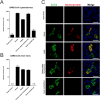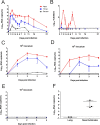Susceptibility of rabbits to SARS-CoV-2
- PMID: 33356979
- PMCID: PMC7832544
- DOI: 10.1080/22221751.2020.1868951
Susceptibility of rabbits to SARS-CoV-2
Abstract
Transmission of severe acute respiratory coronavirus-2 (SARS-CoV-2) between livestock and humans is a potential public health concern. We demonstrate the susceptibility of rabbits to SARS-CoV-2, which excrete infectious virus from the nose and throat upon experimental inoculation. Therefore, investigations on the presence of SARS-CoV-2 in farmed rabbits should be considered.
Keywords: COVID-19; Rabbit; SARS-CoV-2; coronavirus; susceptibility; transmission.
Conflict of interest statement
No potential conflict of interest was reported by the author(s).
Figures



Similar articles
-
Susceptibility of livestock and companion animals to COVID-19.J Med Virol. 2021 Mar;93(3):1351-1360. doi: 10.1002/jmv.26621. Epub 2020 Nov 10. J Med Virol. 2021. PMID: 33090532 Review.
-
Susceptibility of livestock to SARS-CoV-2 infection.Emerg Microbes Infect. 2021 Dec;10(1):2199-2201. doi: 10.1080/22221751.2021.2003724. Emerg Microbes Infect. 2021. PMID: 34749583 Free PMC article.
-
Susceptibility and Attenuated Transmissibility of SARS-CoV-2 in Domestic Cats.J Infect Dis. 2021 Apr 23;223(8):1313-1321. doi: 10.1093/infdis/jiab104. J Infect Dis. 2021. PMID: 33605423 Free PMC article.
-
SARS-CoV-2 in animals: From potential hosts to animal models.Adv Virus Res. 2021;110:59-102. doi: 10.1016/bs.aivir.2021.03.004. Epub 2021 Apr 7. Adv Virus Res. 2021. PMID: 34353482 Free PMC article.
-
Characteristics and Timing of Initial Virus Shedding in Severe Acute Respiratory Syndrome Coronavirus 2, Utah, USA.Emerg Infect Dis. 2021 Feb;27(2):352-359. doi: 10.3201/eid2702.203517. Epub 2020 Dec 4. Emerg Infect Dis. 2021. PMID: 33275874 Free PMC article. Review.
Cited by
-
Genetic tracing of market wildlife and viruses at the epicenter of the COVID-19 pandemic.Cell. 2024 Sep 19;187(19):5468-5482.e11. doi: 10.1016/j.cell.2024.08.010. Cell. 2024. PMID: 39303692
-
COVID-19 and One Health: potential role of human and animals in SARS-CoV-2 life cycle.Sci One Health. 2023 Jun 2;2:100017. doi: 10.1016/j.soh.2023.100017. eCollection 2023. Sci One Health. 2023. PMID: 39077046 Free PMC article. Review.
-
Immunobiology of COVID-19: Mechanistic and therapeutic insights from animal models.Zool Res. 2024 Jul 18;45(4):747-766. doi: 10.24272/j.issn.2095-8137.2024.062. Zool Res. 2024. PMID: 38894519 Free PMC article. Review.
-
Analysis the molecular similarity of least common amino acid sites in ACE2 receptor to predict the potential susceptible species for SARS-CoV-2.PLoS One. 2024 May 2;19(5):e0293441. doi: 10.1371/journal.pone.0293441. eCollection 2024. PLoS One. 2024. PMID: 38696505 Free PMC article.
-
SARS-CoV and SARS-CoV -2 cross-reactive antibodies in domestic animals and wildlife in Nigeria suggest circulation of sarbecoviruses.One Health. 2024 Mar 12;18:100709. doi: 10.1016/j.onehlt.2024.100709. eCollection 2024 Jun. One Health. 2024. PMID: 38533194 Free PMC article.
References
-
- World Health Organization. Coronavirus disease (COVID-19) pandemic . 2020. Available from: https://www.who.int/emergencies/diseases/novel-coronavirus-2019.
-
- Chan JF, Zhang AJ, Yuan S, et al. . Simulation of the clinical and pathological manifestations of Coronavirus Disease 2019 (COVID-19) in golden Syrian hamster model: implications for disease pathogenesis and transmissibility. Clin Infect Dis. 2020 Mar 26. doi:10.1093/cid/ciaa325. PubMed PMID: 32215622; PubMed Central PMCID: PMCPMC7184405. - DOI - PMC - PubMed
-
- Fagre A, Lewis J, Eckley M, et al. . SARS-CoV-2 infection, neuropathogenesis and transmission among deer mice: Implications for reverse zoonosis to New World rodents. bioRxiv. 2020 Aug 7. doi:10.1101/2020.08.07.241810. PubMed PMID: 32793912; PubMed Central PMCID: PMC7418741. eng. - DOI - PMC - PubMed
MeSH terms
Substances
Grants and funding
LinkOut - more resources
Full Text Sources
Other Literature Sources
Medical
Research Materials
Miscellaneous

